
 |
The Infinite Variety of Plate Singles
By John M. Hotchner
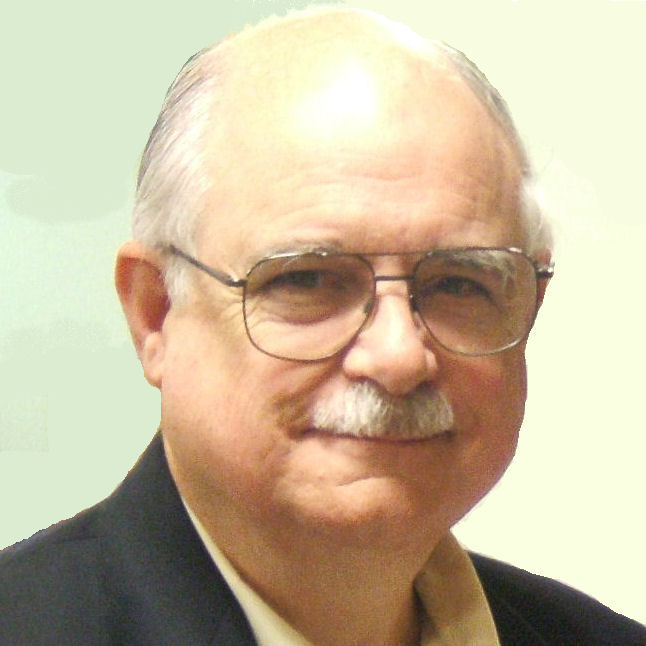
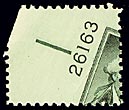 Whether one number on a modern coil stamp, or partial numbers on an older miscut coil or booklet; multiple numbers in the margin of sheet stamps, or a single number with one stamp of a sheet, plate singles give us a complicating factor that increases the challenge level for U.S. stamp collectors who find them fascinating.
Whether one number on a modern coil stamp, or partial numbers on an older miscut coil or booklet; multiple numbers in the margin of sheet stamps, or a single number with one stamp of a sheet, plate singles give us a complicating factor that increases the challenge level for U.S. stamp collectors who find them fascinating.
They can also be ignored by those of us who just want to collect one mint and/or used copy of each U.S. stamp. But sooner or later, all of us will hold in our hands a stamp with a plate number, and have to decide what to do with it. I hope none of us rejects it, and most of us put it into our album, thinking "Well, that's interesting."
But some collectors will be bitten by the bug, and our reaction will leap off from "Well, that's interesting," to "I'm going to look for more of these." Indeed some U.S. collectors do try to get a mint or used plate single of each U.S. stamp. Curiously, despite the fact that most plate number margins are torn off by stamp users before the stamps have been put on envelopes — making them relatively scarce compared to a routine single — most examples for the last 75 years or so, whether mint or used, cost only a few more cents than buying a "normal" stamp.
 This is because of the law of supply and demand: There are not hordes of collectors chasing plate singles.
This is because of the law of supply and demand: There are not hordes of collectors chasing plate singles.
I was recently asked to assist the family of a long-time now deceased friend with selling off her collections, most of which were U.S., including much duplication. She and I had corresponded and met at shows for the better part of 25 years. I thought I knew what she collected.
But I was surprised that she seemed to have picked up an interest in plate singles along the way, and though she seems not to have made a mission of it — and certainly never mentioned it to me as being among her favorite collecting areas — her holdings tell me that whenever she had a chance to pick up a plate single at a good price, she did so.
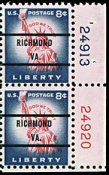 One result is that going back to the first Bureau issue of 1894, she has a good many desirable stamps that gave her a sense of satisfaction and pride as she worked with her collection, and as she added to it.
One result is that going back to the first Bureau issue of 1894, she has a good many desirable stamps that gave her a sense of satisfaction and pride as she worked with her collection, and as she added to it.
But one does not need to collect every plate number to enjoy this pursuit. There are other ways, and having fallen into this collecting area nearly 50 years ago, I want to share some of them with you as possible byways that you might travel as a means of enjoying your collection.
My first foray into plate singles was with the Liberty issue of 1954. The sheet stamps of that issue number 25 to 30, depending upon what you choose to include. But each one was printed by multiple plates, a total of nearly 1,100. Most of those were 3¢, 4¢ and 5¢ plates, the first class rates in effect while the Liberties were current. I decided to collect used plate singles, to minimize the cost. All these years later, I am missing only two sheet stamp numbers; but I branched out into the coil and booklet plate numbers, and I have only about half of the 500 or so that exist.
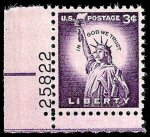 I made an exception to used plate singles for the 8¢ flat plate/rotary Statue of Liberty as it has two adjoining plate numbers on adjoining margin tabs (Figure 2, left), and the combinations are important. There were 14 blue frame plates assigned, and 11 red vignette plates, but 65 known combinations. 24915 (blue) with 24920 (red) is the toughest, valued at $3,500 in the 2008 Durland Standard Plate Number Catalog, published by the United States Stamp Society. I'm missing only that one, and it is probably beyond me!
I made an exception to used plate singles for the 8¢ flat plate/rotary Statue of Liberty as it has two adjoining plate numbers on adjoining margin tabs (Figure 2, left), and the combinations are important. There were 14 blue frame plates assigned, and 11 red vignette plates, but 65 known combinations. 24915 (blue) with 24920 (red) is the toughest, valued at $3,500 in the 2008 Durland Standard Plate Number Catalog, published by the United States Stamp Society. I'm missing only that one, and it is probably beyond me!
There is one other issue that I collect as mint blocks — the 1958 postage dues. The plate that printed the stamp frame did not print the value. That was added later by a rubber mat, in the same way that Bureau precancels were created after the printing of the basic stamp. For that reason, several different values can be associated with a single plate number. The combinations are all known. (For instance the first plate number of the '58s is 26289. It is associated with the 1/2¢, 1¢, 2¢, 3¢, 4¢, 5¢, 6¢, 7¢, 10¢, 30¢ and 50¢; all shiny gum only. Some later plate numbers can also be found on both shiny gum and dull gum varieties.)
I'm still filling in gaps, and while I'm at it, looking for the same plate numbers on shiny and dull gum plate singles and blocks.
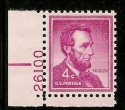 An even greater challenge was found when I found my first precancelled plate single. I have collected Bureau precancels since I was 13, and in my 20s, as children began to come along, I spent a lot of time on that collection as it was all I could afford. I noticed how seldom I found a precancelled plate single, or miscut precancelled coil with a partial plate number; and at some point decided to seek out these rare but still inexpensive stamps. Rather than collecting for completion, as I don't know what completion is, I accumulate these stamps — Bureau or locally precancelled — and now have thousands.
An even greater challenge was found when I found my first precancelled plate single. I have collected Bureau precancels since I was 13, and in my 20s, as children began to come along, I spent a lot of time on that collection as it was all I could afford. I noticed how seldom I found a precancelled plate single, or miscut precancelled coil with a partial plate number; and at some point decided to seek out these rare but still inexpensive stamps. Rather than collecting for completion, as I don't know what completion is, I accumulate these stamps — Bureau or locally precancelled — and now have thousands.
Finally, I have an interest in stamp printing technology, which has led me to collect Errors, Freaks and Oddities, the mistakes that occur in the printing, perforating and booklet forming processes. Plate number EFOs include such items as tagging ghosts, split numbers, misplaced numbers, inverted numbers, malformed numbers, light numbers, missing numbers, doubled numbers, and more. Again, I know what might exist, but not what does exist. So this is an accumulation; just fun stuff it pleases me to look at every so often.
 Where to get these stamps? They can be found in dealer stocks at stamp shows and bourses; one or two at a time. I have found them in American Philatelic Society circuits nestled among the normal stamps. But the primary resource has been the American Plate Number Single Society, which runs a quarterly members auction. Contacts with other members have also filled some holes; there are presently about 140 members.
Where to get these stamps? They can be found in dealer stocks at stamp shows and bourses; one or two at a time. I have found them in American Philatelic Society circuits nestled among the normal stamps. But the primary resource has been the American Plate Number Single Society, which runs a quarterly members auction. Contacts with other members have also filled some holes; there are presently about 140 members.
Finally, I want to note that the Durland Plate Number Catalog, which has a 2010 supplement, is a fabulous resource for the serious plate number collector. It lists and values every known plate number used for both regular postage (including coils and booklets) and back of the book issues. And it values each by plate position. One need not be a member of the United States Stamp Society to buy one, but I recommend both membership and the catalog. You can order the Durland and its supplement online in The Virtual Stamp Club Bookstore.
| American Plate Number Single Society APNSS dues are $10 a year, $18 for two years. The bimonthly newsletter Plate Numbers includes an extensive mail auction of plate number material. APNSS also tries to keep its members current on new plate numbers, both through the website and through a column in the newsletter. APNSS also publishes Hebert's Catalog of Plate Number Singles. This nearly 600-page volume lists and prices all plate numbers and positions for mint and used PNS from the Columbians through today, with extensive back-of-the-book listings for PNS of the various types of postal savings stamps, newspaper stamps, duck stamps, postage dues, parcel post, Offices in China, officials, plus PNS of U.S. stamps overprinted for possessions such as Canal Zone and Guam. The 2011 edition is now available at $30 to the general public or $27 to APNSS members, postpaid via Media Mail to U.S. addresses. |
U.S. Stamp Society The USSS is the largest philatelic organization dedicated to the research and study of United States postage and revenue stamps. Members receive the authoritative monthly journal, The United States Specialist, which is devoted to all aspects of U.S. philately. Members also receive discounts on numerous books published by the Society. Dues are $25.00 per year. Write to USSS, P.O. Box 6634, Katy, TX 77491-6634. |
Should you wish to comment on this editorial, or have questions or ideas you would like to have explored in a future column, please write to John Hotchner, VSC Contributor, P.O. Box 1125, Falls Church, VA 22041-0125, or email, putting "VSC" in the subject line, at jmhstamp@verizon.net